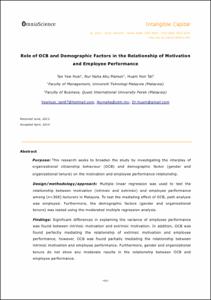Mostra el registre d'ítem simple
Role of OCB and demographic factors in the relationship of motivation and employee performance
| dc.contributor.author | Tan Yew Huei |
| dc.contributor.author | Nur Naha Abu Mansor |
| dc.contributor.author | Huam Hon Tat |
| dc.date.accessioned | 2015-02-26T13:41:00Z |
| dc.date.available | 2015-02-26T13:41:00Z |
| dc.date.issued | 2014-06 |
| dc.identifier.citation | Tan Yew Huei; Nur Naha Abu Mansor; Huam Hon Tat. Role of OCB and demographic factors in the relationship of motivation and employee performance. "", Juny 2014, vol. 10, núm. 3, p. 425-447. |
| dc.identifier.issn | 1697-9818 |
| dc.identifier.issn | 2014-3214 |
| dc.identifier.uri | http://hdl.handle.net/2099/16102 |
| dc.description.abstract | Purpose: This research seeks to broaden the study by investigating the interplay of organizational citizenship behaviour (OCB) and demographic factor (gender and organizational tenure) on the motivation and employee performance relationship. Design/methodology/approach: Multiple linear regression was used to test the relationship between motivation (intrinsic and extrinsic) and employee performance among (n=368) lecturers in Malaysia. To test the mediating effect of OCB, path analysis was employed. Furthermore, the demographic factors (gender and organizational tenure) was tested using the moderated multiple regression analysis. Findings: Significant differences in explaining the variance of employee performance was found between intrinsic motivation and extrinsic motivation. In addition, OCB was found perfectly mediating the relationship of extrinsic motivation and employee performance, however, OCB was found partially mediating the relationship between intrinsic motivation and employee performance. Furthermore, gender and organizational tenure do not show any moderate results in the relationship between OCB and employee performance. Research limitations/implications: Study limitations (e.g. cross-sectional research design and biasness) and future opportunities are outlined. Practical implications: Argues that the suitable type of motivation in explaining the variances of employee performance. Also, identifies the important of OCB between the motivation and employee performance relationship, thus gender and organizational tenure were not significant to OCB and employee performance relationship. Social implications: HR can help an organization to succeed, provided that the suitable motivations are adopted to monitor lecturer performance and helping behavior. In addition, HR should not emphasize too much of gender and organizational tenure to justify the lecturer performance as the findings show insignificant relationship. Originality/value: This paper identifies and discusses the types of motivation that explain higher variance of employee performance and how OCB play role as mediator in the motivation and employee performance relationship. In addition, the moderating effect of gender and organizational tenure were also discussed. This is the first attempt to include all the variables in the same theoretical framework |
| dc.format.extent | 23 p. |
| dc.language.iso | eng |
| dc.publisher | OmniaScience |
| dc.rights | Attribution-NonCommercial-NoDerivs 3.0 Spain |
| dc.rights.uri | http://creativecommons.org/licenses/by-nc-nd/3.0/es/ |
| dc.subject | Àrees temàtiques de la UPC::Economia i organització d'empreses::Gestió i direcció::Recursos humans |
| dc.subject | Àrees temàtiques de la UPC::Economia i organització d'empreses::Competitivitat i innovació |
| dc.subject.lcsh | Intrinsic motivation |
| dc.subject.lcsh | Management--Employee participation |
| dc.subject.lcsh | Employee Performance Appraisal |
| dc.subject.other | Extrinsic motivation |
| dc.subject.other | Organizational citizenship behaviour |
| dc.subject.other | Gender and organizational tenure |
| dc.title | Role of OCB and demographic factors in the relationship of motivation and employee performance |
| dc.type | Article |
| dc.subject.lemac | Motivació (Psicologia)| |
| dc.subject.lemac | Treballadors -- Motivació |
| dc.subject.lemac | Treballadors -- Avaluació |
| dc.identifier.doi | 10.3926/ic.435 |
| dc.identifier.dl | B-33375-2004 |
| dc.description.peerreviewed | Peer Reviewed |
| dc.rights.access | Open Access |
| local.citation.author | Tan Yew Huei; Nur Naha Abu Mansor; Huam Hon Tat |
| local.citation.volume | 10 |
| local.citation.number | 3 |
| local.citation.startingPage | 425 |
| local.citation.endingPage | 447 |


